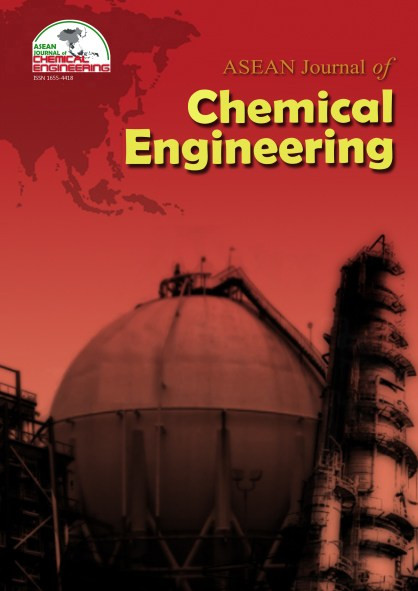The Efficiency of κ-Carrageenan-Chitosan-PVA-MWCNTs Membranes in Removing Methylene Blue, Rhodamine B, Bromocresol Purple, and Murexid from Water
Abstract
The electrocoagulation method has been proven to be highly effective in removing metal ions from water, with a removal efficiency of over 97%. However, in terms of removing organic pollutants such as synthetic dyes, the efficiency of electrocoagulation is still relatively low. A hybrid approach combining electrocoagulation with membrane filtration has been proposed to enhance the removal of organic contaminants. Eco-friendly membranes made from renewable natural polymers like carrageenan and chitosan, reinforced with synthetic polymers such as polyvinyl alcohol and carbon nanotubes, have shown to be promising for this application. In this study, membranes with varying chitosan/carrageenan ratios of 0.2, 0.33, 0.5, and 0.71 (g/g) were used to remove synthetic dyes, including methylene blue, rhodamine B, bromocresol purple, and murexid, at a concentration of 200 ppm from 8.5 ml of water. From the SEM images, the four membranes have almost the same surface and cross-section morphology. The results showed that the membrane with a chitosan/carrageenan ratio of 0.71 exhibited the highest removal efficiency for all synthetic dyes. The parameter affecting the membrane’s removal efficiency is the interaction between the membrane and synthetic dyes. Murexid, an anionic dye, achieved a 100% removal efficiency, surpassing cationic dyes such as rhodamine B and methylene blue. Besides interactions, the dye’s molecular size determines the removal’s efficiency. The molecular size of rhodamine B is larger than that of methylene blue, and the removal efficiency of rhodamine B (98.4%) is greater than methylene blue (91%). Bromocresol purple is almost the same size as rhodamine B but not ionic because it has the lowest removal efficiency of 34.55%.
References
Alshahrani, A. A., Algamdi, M. S., Alsohaimi, I. H., Nghiem, L. D., Tu, K. L., Al-Rawajfeh, A. E., & in het Panhuis, M., 2020. “The rejection of mono- and di-valent ions from aquatic environment by MWNT/chitosan buckypaper composite membranes: Influences of chitosan concentrations.” Separation and Purification Technology, 234, 116088.
Alshahrani, A. A., Al-Zoubi, H., Nghiem, L. D., & in het Panhuis, M., 2017. “Synthesis and characterisation of MWNT/chitosan and MWNT/chitosan-crosslinked buckypaper membranes for desalination.” Desalination, 418, 60–70.
Alshahrani, A., Alharbi, A., Alnasser, S., Almihdar, M., Alsuhybani, M., and AlOtaibi, B., 2021. “Enhanced heavy metals removal by a novel carbon nanotubes buckypaper membrane containing a mixture of two biopolymers: Chitosan and i-carrageenan.” Separation and Purification Technology, 276, 119300.
Bandehali, S., Sanaeepur, H., Ebadi Amooghin, A., Shirazian, S., and Ramakrishna, S., 2021. “Biodegradable polymers for membrane separation.” Separation and Purification Technology, 269, 118731.
Duman, O., Polat, T. G., Diker, C. Ö., and Tunç, S., 2020. “Agar/κ-carrageenan composite hydrogel adsorbent for the removal of methylene blue from water.” International Journal of Biological Macromolecules, 160, 823–835.
Ngoma, M. M., Mathaba, M., and Moothi, K., 2021. “Removal of Cu2+, Fe2+, Ni2+, Zn2+ and Cl− from industrial wastewater using a polyethersulfone/ carbon nanotube/ polyvinyl alcohol composite membrane.” Environmental Challenges, 4, 100116.
Phan, D. N., Khan, M. Q., Nguyen, N. T., Phan, T. T., Ullah, A., Khatri, M., Kien, N. N., and Kim, I. S., 2021. “A review on the fabrication of several carbohydrate polymers into nanofibrous structures using electrospinning for removal of metal ions and dyes.” Carbohydrate Polymers, 252, 117175.
Shaari, N. and Kamarudin, S. K., 2015. “Chitosan and alginate types of bio-membrane in fuel cell application: An overview.” Journal of Power Sources, 289, 71–80.
Shahedi, A., Darban, A. K., Taghipour, F., and Jamshidi-Zanjani, A., 2020. “A review on industrial wastewater treatment via electrocoagulation processes.” Current Opinion in Electrochemistry, 22, 154–169.
Sianipar, M., Kim, S. H., Khoiruddin, Iskandar, F., and Wenten, I. G., 2017. “Functionalized carbon nanotube (CNT) membrane: Progress and challenges.” RSC Advances, 7(81), 51175–51198.
Sivakumar, R. and Lee, N. Y., 2022. Adsorptive removal of organic pollutant methylene blue using polysaccharide-based composite hydrogels. Chemosphere, 286, 131890.
Tahreen, A., Jami, M. S., and Ali, F., 2020. Role of electrocoagulation in wastewater treatment: A developmental review. Journal of Water Process Engineering, 37, 101440.
Udayakumar, G. P., Muthusamy, S., Selvaganesh, B., Sivarajasekar, N., Rambabu, K., Sivamani, S., Sivakumar, N., Maran, J. P., and Hosseini-Bandegharaei, A., 2021. “Ecofriendly biopolymers and composites: Preparation and their applications in water-treatment.” Biotechnology Advances, 52, 107815.
Widarti, S. and Raharjo, A. H., 2021. Initial pH influence on organic pollutants, total suspended solids, and nickel removal from citarum river water using electrocoagulation. Proceedings of the 2nd International Seminar of Science and Applied Technology (ISSAT 2021), 207, 93–100.
Copyright holder for articles is ASEAN Journal of Chemical Engineering. Articles published in ASEAN J. Chem. Eng. are distributed under a Creative Commons Attribution-NonCommercial 4.0 International (CC BY-NC 4.0) license.
Authors agree to transfer all copyright rights in and to the above work to the ASEAN Journal of Chemical Engineering Editorial Board so that the Editorial Board shall have the right to publish the work for non-profit use in any media or form. In return, authors retain: (1) all proprietary rights other than copyright; (2) re-use of all or part of the above paper in their other work; (3) right to reproduce or authorize others to reproduce the above paper for authors’ personal use or for company use if the source and the journal copyright notice is indicated, and if the reproduction is not made for the purpose of sale.


